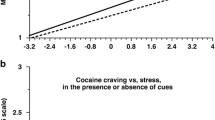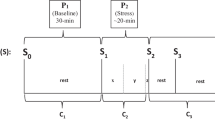Abstract
Rationale
Cue-elicited craving and stress responses have been identified as predictors of relapse in drug dependence, but little research exists on the contribution of these factors to marijuana use specifically.
Objectives
The aims of the present study were to evaluate (1) responses to a psychological stressor, (2) responses to marijuana-related cues, and (3) if an exposure to a psychological stressor augmented craving subsequently elicited by marijuana-related cue exposure in marijuana-dependent individuals.
Methods
Subjective (craving, stress), neuroendocrine (adrenocorticotropic hormone (ACTH), cortisol), and physiologic responses to the presentation of neutral and marijuana cues were assessed after randomization to a stress (Trier Social Stress Task (TSST)) or non-stress control condition in marijuana-dependent individuals. Outcome measures were assessed at baseline, post-stressor/pre-neutral cue, post-neutral cue, and post-marijuana cue.
Results
Eighty-seven participants completed procedures (stress group, n = 45; non-stress group, n = 42). The stress group had a significant increase over the non-stress group in stress rating (p < 0.001), craving (p = 0.028), cortisol (p < 0.001), and ACTH (p < 0.001) after the completion of the TSST. An increased craving response for all participants was seen following the presentation of the marijuana cues (p = 0.005). Following the TSST or non-stress condition, the non-stress group had an increase in craving to marijuana cues as compared to neutral cues (p = 0.002); an increase in craving was not observed in the stress group (p = 0.404).
Conclusions
Marijuana cue exposure and a social stressor increased craving in marijuana-dependent individuals. Completion of the TSST did not increase craving response to subsequent marijuana cue exposure.


Similar content being viewed by others
References
Bonn-Miller MO, Zvolensky MJ, Bernstein A (2007) Marijuana use motives: concurrent relations to frequency of past 30-day use and anxiety sensitivity among young adult marijuana smokers. Addict Behav 32:49–62
Brady KT, Back SE, Waldrop AE, McRae AL, Anton RF, Upadhyaya HP, Saladin ME, Randall PK (2006) Cold pressor task reactivity: predictors of alcohol use among alcohol-dependent individuals with and without comorbid posttraumatic stress disorder. Alcohol Clin Exp Res 19:600–606
Bremner JD, Southwick SM, Darnell A, Charney DS (1996) Chronic PTSD in Vietnam combat veterans: course of illness and substance abuse. Am J Psychiatry 153:369–375
Buchmann AF, Laucht M, Schmid B, Wiedemann K, Mann K, Zimmermann US (2010) Cigarette craving increases after a psychosocial stress test and is related to cortisol stress response but not to dependence scores in daily smokers. J Psychopharmacol 24:247–255
Burnham KP, Anderson DR (2002) Model selection and multi-model inference: a practical information-theoretic approach. Springer, New York
Childress AR, McLellan AT, Ehrman R, O’Brien CP (1988) Classically conditioned responses in opioid and cocaine dependence: a role in relapse? NIDA Res Monogr 84:25–43
Childs E, de Wit H (2010) Effects of acute psychological stress on cigarette craving and smoking. Nicotine Tob Res 12:449–453
Coffey SF, Stasiewicz PR, Hughe PM, Brimo ML (2006) Trauma-focused imaginal exposure for individuals with comorbid posttraumatic stress disorder and alcohol dependence: revealing mechanisms of alcohol craving in a cue reactivity paradigm. Psychol Addict Behav 20:425–435
Conklin CA, Perkins KA (2005) Subjective and reinforcing effects of smoking during negative mood induction. J Abnorm Psychol 114:153–164
Cooney NL, Litt MD, Morse PA, Bauer LA, Gaupp L (1997) Alcohol cue reactivity, negative-mood reactivity, and relapse in treated alcoholic men. J Abnorm Psychol 106:243–250
Copeland J, Swift W, Rees V (2001) Clinical profile of participants in a brief intervention program for cannabis use disorder. J Subst Abuse Treat 20:45–52
DeMarce JM, Stephens RS, Roffman RA (2005) Psychological distress and marijuana use before and after treatment: testing cognitive-behavioral matching hypotheses. Addict Behav 30:1055–1059
Dickerson SS, Kemeny ME (2004) Acute stressors and cortisol responses: a theoretical integration and synthesis of laboratory research. Psychol Bull 130:355–391
Drummond DC, Cooper T, Glautier SP (1990) Conditioned learning in alcohol dependence: implications for cue exposure treatment. Br J Addict 85:725–743
Field M, Eastwood B, Bradley BP, Mogg K (2006) Selective processing of cannabis cues in regular cannabis users. Drug Alcohol Depend 85:75–82
Filbey FM, Schacht JP, Myers US, Chavez RS, Hutchison KE (2009) Marijuana craving in the brain. Proc Natl Acad Sci USA 106(31):13016–13021
Filbey FM, Schacht JP, Myers US, Chavez RS, Hutchison KE (2010) Individual and additive effects of the CNR1 and FAAH genes on brain response to marijuana cues. Neuropsychopharmacology 35:967–975
First MB, Spitzer RL, Gibbon M, Williams JBW (1994) Structured clinical interview for axis 1 DSM-IV disorders—patient edition (SCID-I/P, version 2.0). Biometrics Research Department, New York
Fox HC, Bergquist KL, Hong K, Sinha R (2007) Stress-induced and alcohol cue-induced craving in recently abstinent alcohol-dependent individuals. Alcohol Clin Exp Res 31:395–403
Fishbein DH, Herman-Stahl M, Eldreth D, Paschall MJ, Hyde C, Hubal R, Hubbard S, Williams J, Ialongo N (2006) Mediators of the stress–substance-use relationship in urban male adolescents. Prev Sci 7:113–126
Franken IH, Kroon LY, Wiers RW, Jansen A (2000) Selective cognitive processing of drug cues in heroin dependence. J Psychopharmacol 14:395–400
Galen LW, Henderson MJ (1999) Validation of cocaine and marijuana effect expectancies in a treatment setting. Addict Behav 24:719–724
Gray KM, LaRowe SD, Upadhyay HP (2008) Cue reactivity in young marijuana smokers: a preliminary investigation. Psychol Addict Behav 22:582–586
Hamilton M (1959) The assessment of anxiety states by rating. Br J Med Psychol 32:50–55
Hamilton M (1960) A rating scale for depression. J Neurol Neurosurg Psychiatry 23:56–62
Haughey HM, Marshall E, Schacht JP, Louis A, Hutchison KE (2008) Marijuana withdrawal and craving: influence of the cannabinoid receptor 1 (CNR1) and fatty acid amide hydrolase (FAAH) genes. Addiction 103:1678–1686
Heishman SJ, Evans RJ, Singleton EG, Levin KH, Copersino ML, Gorelick DA (2009) Reliability and validity of a short form of the Marijuana Craving Questionnaire. Drug Alcohol Depend 102:35–40
Hyman SM, Sinha R (2009) Stress-related factors in cannabis use and misuse: implications for prevention and treatment. J Subst Abuse Treat 36:400–413
Jansma A, Breteler MH, Schippers GM, de Jong CA, Van Der Staak CF (2000) No effect of negative mood on the alcohol cue reactivity of in-patient alcoholics. Addict Behav 25:619–624
Kudielka BM, Helhammer DH, Kirschbaum C (2007) Ten years of research with the Trier Social Stress Test—revisited. In: Harmon-Jones E, Winkielman P (eds) Social neuroscience: integrating biological and psychological explanations of social behavior. Guilford, New York, pp 56–83
Lee CM, Neighbors C, Woods BA (2007) Marijuana motives: young adults' reasons for using marijuana. Addict Behav 32:1384–1394
Lipschitz DS, Rasmusson AM, Anyan W, Gueorguieva R, Billingslea EM, Cromwell PF, Southwick SM (2003) Posttraumatic stress disorder and substance use in inner-city adolescent girls. J Nerv Ment Dis 191:714–721
Mason BJ, Light JM, Escher T, Drobes DJ (2008) Effect of positive and negative affective stimuli and beverage cues on measures of craving in non treatment-seeking alcoholics. Psychopharmacology (Berl) 200:141–150
Nesic J, Duka T (2006) Gender specific effects of a mild social stressor on alcohol cue reactivity in heavy social drinkers. Pharmacol Biochem Behav 83:239–248
Niaura RS, Shadel WG, Britt DM, Abrams DB (2002) Response to social stress, urge to smoke, and smoking cessation. Addict Behav 27:241–250
Patterson HD, Thompson R (1971) Recovery of inter-block information when block sizes are unequal. Biometrika 58:545–554
Perkins KA, Grobe JE (1992) Increased desire to smoke during acute stress. Br J Addict 87:1037–1040
Rubonis AV, Colby SM, Monti PM, Rohsenow DJ, Gulliver SB, Sirota AD (1994) Alcohol cue reactivity and mood induction in male and female alcoholics. J Stud Alcohol 55:487–494
Sayette MA, Griffin KM, Sayers WM (2010) Counterbalancing in smoking cue research: a critical analysis. Nicotine Tob Res 12:1068–1079
Schiff M, Zweig HH, Benbenishty R, Hasin DS (2007) Exposure to terrorism and Israeli youths' cigarette, alcohol, and cannabis use. Am J Public Health 97:1852–1858
Sheehan DV, Lecrubier Y (2006) Mini International Neuropsychiatric Interview Plus 500, DSM-IV, http://www.medical-outcomes.com/Downloads/English/index.htm
Simons JS, Gaher RM, Correia CJ, Hansen CL, Christopher MS (2005) An affective-motivational model of marijuana and alcohol problems among college students. Psychol Addict Behav 19:326–334
Singleton EG, Trotman AJM, Zavahir M, Taylor RC, Heishman SJ (2002) Determination of the reliability and validity of the Marijuana Craving Questionnaire using imagery scripts. Exp Clin Psychopharmacol 10:47–53
Sinha R, Fox HC, Hing KA, Berquist KL, Bhagwager Z, Siedlarz KM (2009) Enhanced negative emotion and alcohol craving, and altered physiological responses following stress and cue exposure in alcohol dependent individuals. Neuropsychopharmacology 34:1198–1208
Sobell MB, Sobell LC (1978) Behavioral treatment of alcohol problems. Plenum, New York
Thomas SE, Randall PK, Brady K, See RE, Drobes DJ (2010) An acute psychosocial stressor does not potentiate alcohol cue reactivity in non-treatment-seeking alcoholics. Alcohol Clin Exp Res 35:464–473
Turner NE, Annis HM, Sklar SM (1997) Measurement of antecedents to drug and alcohol use: psychometric properties of the Inventory of Drug-Taking Situations (IDTS). Behav Res Ther 35:465–483
Vlahov D, Galea S, Ahern J, Resnick H, Kilpatrick D (2004) Sustained increased consumption of cigarettes, alcohol, and marijuana among Manhattan residents after September 11, 2001. Am J Public Health 94:253–254
Weiss RD, Griffin ML, Hufford C (1995) Craving in hospitalized cocaine abusers as a predictor of outcome. Am J Drug Alcohol Abuse 21:289–301
Wills TA, Sandy JM, Yaeger AM, Cleary SD, Shinar O (2001) Coping dimensions, life stress, and adolescent substance use: a latent growth analysis. J Abnorm Psychol 110:309–323
Windle M, Wiesner M (2004) Trajectories of marijuana use from adolescence to young adulthood: predictors and outcomes. Dev Psychopathol 16:1007–1027
Wolfling K, Flor H, Grusser SM (2008) Psychophysiological responses to drug-associated stimuli in chronic heavy cannabis use. Eur J Neurosci 27:976–983
Acknowledgments
This study was supported by NIH grants R21DA22424 and M01RR001070.
Author information
Authors and Affiliations
Corresponding author
Rights and permissions
About this article
Cite this article
McRae-Clark, A.L., Carter, R.E., Price, K.L. et al. Stress- and cue-elicited craving and reactivity in marijuana-dependent individuals. Psychopharmacology 218, 49–58 (2011). https://doi.org/10.1007/s00213-011-2376-3
Received:
Accepted:
Published:
Issue Date:
DOI: https://doi.org/10.1007/s00213-011-2376-3




